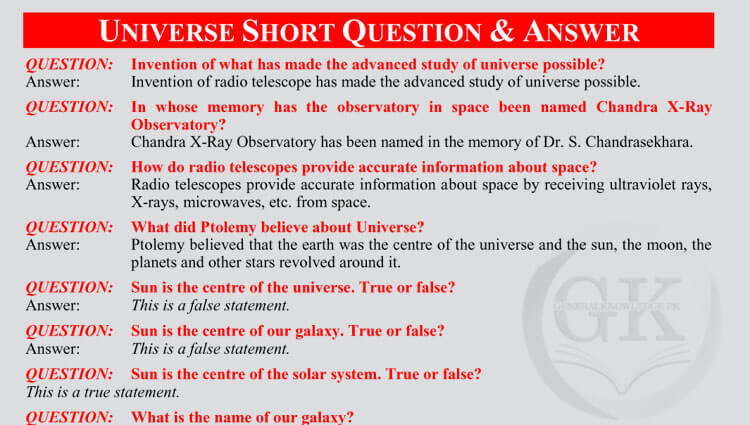Universe Short Question Answer
QUESTION: Invention of what has made the advanced study of universe possible?
Answer: Invention of radio telescope has made the advanced study of universe possible.
QUESTION: In whose memory has the observatory in space been named Chandra X-Ray Observatory?
Answer: Chandra X-Ray Observatory has been named in the memory of Dr. S. Chandrasekhara.
QUESTION: How do radio telescopes provide accurate information about space?
Answer: Radio telescopes provide accurate information about space by receiving ultraviolet rays, X-rays, microwaves, etc. from space.
QUESTION: What did Ptolemy believe about Universe?
Answer: Ptolemy believed that the earth was the centre of the universe and the sun, the moon, the planets and other stars revolved around it.
Check also: World General Knowledge MCQs
QUESTION: Sun is the centre of the universe. True or false?
Answer: This is a false statement.
QUESTION: Sun is the centre of our galaxy. True or false?
Answer: This is a false statement.
QUESTION: Sun is the centre of the solar system. True or false?
This is a true statement.
QUESTION: What is the name of our galaxy?
Answer: The name of our galaxy is Milky Way.
QUESTION: What does our solar system consist of /
Answer: Our solar system consists of the Sun, nine planets revolving around the Sun, ninety one satellites revolving around different planets, more than one lakh asteroids, meteors, comets, etc.
QUESTION: Which force keeps the planets in their orbits?
Answer: The centripetal (gravitational) force between the Sun and the planets keeps the planets in their orbits.
QUESTION: What is photosphere?
Answer: Photosphere is the 400 km thick, bright layer around the Sun.
QUESTION: What is ‘Corona’?
Answer: A thin layer of gases around the photosphere of the Sun which becomes visible at the time of solar eclipse is called ‘Corona’.
QUESTION: What is the temperature in the core region of Sun?
Answer: The temperature in the core region of Sun is about 1.5 crore K.
QUESTION: What happens during the thermonuclear fusion taking place in Sun?
Answer: During thermonuclear fusion taking place in sun, four hydrogen nuclei fuse to form a helium nucleus.
QUESTION: Mention Einstein’s mass-energy relation.
Answer: Einstein’s mass-energy relation is: E = Δmc2, where Δm is the change in mass and c is the velocity of light in vacuum.
QUESTION: What is the mass of sun?
Answer: The mass of sun is about 1.99 x 1030 kg.
QUESTION: Which two elements are chiefly the constituents of sun?
Answer: Hydrogen and helium are chiefly the constituent elements of sun.
QUESTION: Mention the names of terrestrial planets.
Answer: Mercury, Venus, Earth and Mars are the terrestrial planets.
QUESTION: What does the atmosphere of Venus contain?
Answer: The atmosphere of Venus contains carbon dioxide gas.
QUESTION: Why does the sun rise in the west on Venus?
Answer: The sun rises in the west on Venus because unlike other planets Venus spins in the opposite direction (i.e. from east to west).
QUESTION: Name the two planets which do not have natural satellites.
Answer: Mercury and Venus do not have natural satellites.
QUESTION: Which layer of the atmosphere protects us from ultraviolet rays of sun?
Answer: Ozone layer of the atmosphere protects us from ultraviolet rays of sun.
QUESTION: What does the core region of earth contain?
Answer: The core region of earth contains molten mass consisting of iron, magnesium, silica, etc.
QUESTION: What does the atmosphere of mars mainly consist of?
Answer: The atmosphere of mars mainly consists of carbon dioxide.
Check more World General Knowledge Notes below:
- An Overview of the Punjab Assembly: How it Works and what it does
- 10 Attractive Facts About Pakistan You Must Know
- Universe Short Question Answer (Set-I) | World General Knowledge
- Handwritten Notes for Preparation of FIA Tests (PDF File)
- DETAILS OF PLANETS | Geography
- Famous Doctrines of the World
- Important Dynasties and Empires of the World
- Important Pakistan’s Military Operations
- World Day of Remembrance for Road Traffic Victims
- Do you know what languages these words originate from? (World Language MCQs)
